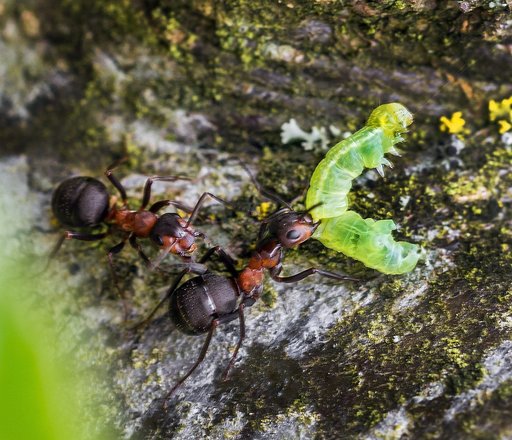Ants actively combat plant diseases in the ‘AntFarm’ project
Ants secrete antibiotic substances and have a close relationship with bacteria that can combat various diseases according to a new scientific article from Aarhus University. Researchers are now testing whether they can cultivate wood ants for organic control of plant diseases and pests in, for example, apple orchards.
The small industrious wood ant can do more than just build high nests in spruce forests. A newly published scientific article in the journal Microbial Ecology reveals that ants combat a range of plant diseases, including those affecting apples. At the same time, ants hunt pests like winter moth larvae, which can defoliate apple trees, to feed their larvae. This opens up entirely new perspectives for biological control of plant diseases.
In light of these new results, researchers have now initiated the ‘AntFarm’ project, which aims to develop methods to cultivate wood ants for use in organic apple orchards.
Very clean communities
Ants live incredibly close together in very large communities. As in all other dense communities, there is a high risk of rapid spread of diseases. This is a problem that ants have developed effective measures against through long evolution.
“Ants are extremely clean,” explains senior researcher Joachim Offenberg from the Department of Ecoscience, Aarhus University, who has studied ant communities for many years and is a co-author of the scientific article. Ant communities have their own dung heaps, located away from the nest, and their own garbage collectors. Some species even have the ability to remove waste from the nest and dump it in streams. Moreover, ants are the only animals that have developed a gland on their bodies that secretes antibiotic substances. Researchers describe this as the ants’ internal stable defence.
Interaction with bacteria

But ants have more tricks up their sleeves. Researchers have previously shown that wood ants reduce diseases like scab and apple rot in apple orchards. However, they were not entirely sure what was causing the positive effect.
“A possible answer lies in the bacteria and fungi that live on the ants’ legs,” says Ida Cecilie Jensen, a PhD student at the Department of Ecoscience, Aarhus University, who led the investigations. Through relatively simple experiments, researchers showed that they could prevent apple rot fungus from growing on agar plates if ants had walked on the plates. They also rinsed the ants with water and found that this “rinsing water” could combat the growth of apple rot fungus.
Researchers managed to isolate five species of microorganisms that live on the ants’ legs. Two of them combat both apple rot and apple scab—diseases that have significant economic impact on apple production. One of these microorganisms also combats two other important plant diseases: grey mould and fusarium head blight, which attack hundreds of different crops. The promising effects of ants against various diseases, as well as their impact on pests, make them promising candidates for biological control of diseases and pests.
Bacteria have a very short generation time, and the interaction with bacteria can be interpreted as the ants’ external defence mechanism, which can quickly adapt to new conditions.
New perspectives with AntFarm
The world spends billions each year on chemical pesticides to combat plant diseases. However, these have a range of harmful effects and also impact human health. “If we use ants and the microorganisms associated with them to combat pests and plant diseases, we ensure a much more sustainable and climate-friendly production,” says an enthusiastic Ida Cecilie Jensen, who also points out that organic fruit growers otherwise only have access to a few tools to combat diseases and pests.
Researchers have now initiated the AntFarm project to investigate whether it is possible to cultivate wood ants on a large scale for relocation in organic apple orchards.
“We expect that organic fruit growers will achieve higher and more stable yields with the help of ants, while also increasing biodiversity in the orchards,” says Ida Cecilie Jensen.
Over the next two years, AntFarm will assess the economic feasibility of cultivating ants for biological control, and the researchers have high expectations regarding the antibiotic substances produced by the ants’ microorganisms.
Around the world, researchers are currently investigating whether we can also use the antibiotic substances from ants and their microorganisms to combat diseases in humans, who are increasingly plagued by diseases that develop resistance to known antibiotics.
Info box
The study is supported by GUDP/ICROFS through the project Open Field Biocontrol (34009-19-1562) and by the Novo Nordic Foundation through Plant Science, Agriculture and Food Biotechnology Project grants 2021.
AntFarm is supported by the GUDP/ICROFS Organic RDD 5 project, ICROFS stands for International Center for Research in Organic Agriculture and Food Systems and is set up and financially supported by the Ministry of Food, Agriculture and Fisheries.
- Read the international article here: https://link.springer.com/article/10.1007/s00248-024-02464-2
- Read more about AntFarm here: https://icrofs.dk/forskning/organic-rdd-8/antfarm
Further information:
- Joachim Offenberg, Senior Researcher, Department of Ecoscience, Aarhus University. joaf@ecos.au.dk; Phone: +45 2558 0680
- Ida Cecilie Jensen, PhD student, Department of Ecoscience, Aarhus University. Email: icj@ecos.au.dk; Phone: +45 5186 4690




